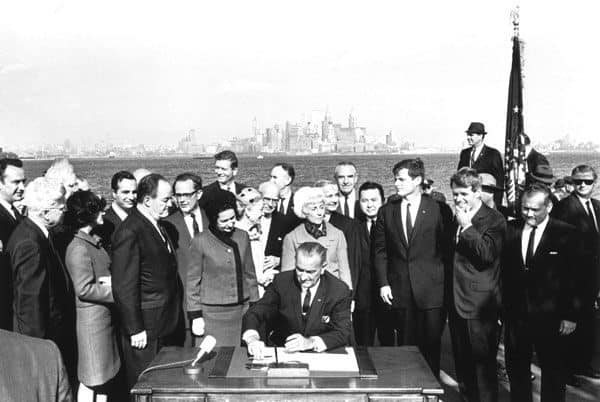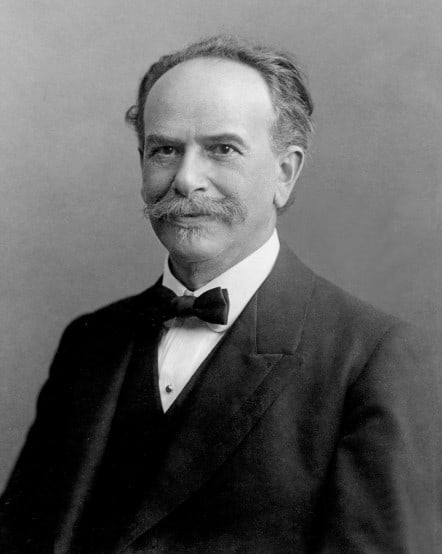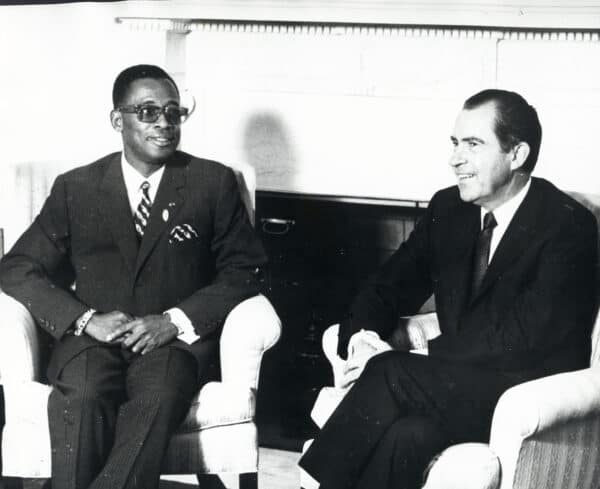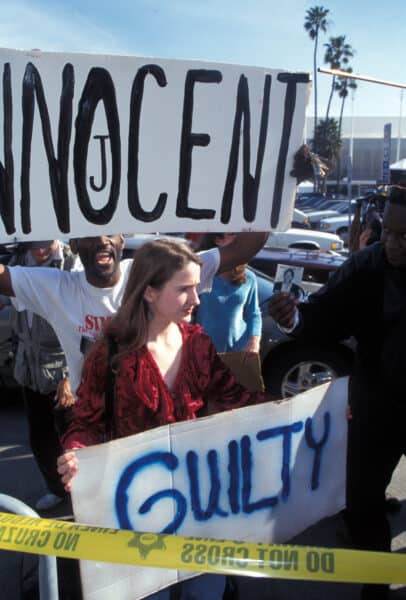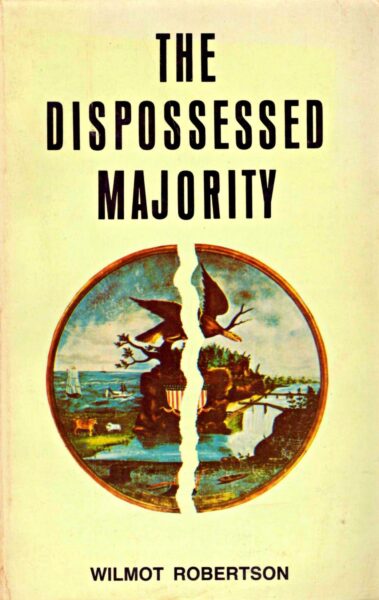“History is insistent on pointing out that when the dominant population group goes, the country goes. As is daily becoming more apparent, the dying fall of the American Majority is the dying fall of America itself.”
If America continues to decline, it will be one of the most amazing and depressing stories ever told. The United States will have gone from almost absolute leadership of the world in the 20th century to just another mediocrity in a very short time. Future Chinese historians will ponder the rapid collapse of such a dynamic nation and wonder what it may mean for their own civilization. For that, they can find no better guide than The Dispossessed Majority (TDM).
Written by Wilmot Robertson in 1972, the author described his book as “an elegy” for a great nation that no longer existed. But much more than that, he explained in detail how and why dispossession happened and even proposed an idea for a renewal, not only for America, but for whites worldwide. Even in 1972, conservatives knew something was wrong with America and were sounding the alarm: high taxes, too much regulation, lack of religion in schools, Marxism, unions, political corruption and loose morals. Their nostrums — cut taxes and government, strengthen the military, and promote “family values” — had no effect on halting America’s descent.
TDM offered one reason for decline. Whites — America’s founders and sustainers — were no longer in charge of the nation they had built. They were also being submerged by racially-conscious non-whites who could never assimilate into American life and would never put country before race. Let us not forget that Robertson started writing TDM in the early-1960s when the US was still about 90 percent white. The rot had set in decades before the US was colonized by the Third World.
Prelude to dispossession
Robertson argues that already by 1972, whites had lost their country, and that his book “records the sorry chronicle of Majority reverses on all the important battlegrounds — cultural, religious, political, economic and diplomatic. Since the liberal-minority coalition has emerged victorious on all fronts, it is not an overstatement to describe the losers as the Dispossessed Majority.”
TDM has 39 chapters in 10 sections that go into detail about how whites were dispossessed. Robertson names names, cites dates, and includes an amazing number of little-known facts, often in footnotes. That he did this alone and in pre-internet days is a testament to the author’s knowledge, research, and dedication. You can hardly get a better lesson in real American history. Nor is this dry history; Robertson makes the story of America come alive.
The first section of TDM is called Racial Dynamics. Though we all belong to the same species, humans belong to races. TDM cites hard data on biology and race, but Robertson writes that race — sometimes hard to define with precision — can also be “sensed.” It is an essential element of being human, because men can give up religion, country, or culture, but cannot give up race. It is trendy to say that race doesn’t exist or that whites made it up to justify colonization. Yet racial classification goes back to at least the Bible, which divided mankind into three races. Egyptian depictions show clear racial division with light skinned rulers, tanned workers, and black slaves. The Indian caste system was set up 2,500 years ago and was determined by color and nose shape.
The ancient Greeks tried to understand racial differences. Hippocrates thought climate and geography might have caused different racial temperaments. But it was not until the early 20th century that a comprehensive theory of racial equality was developed. Columbia anthropology professor Franz Boas theorized that culture, not biology, explained racial differences and even claimed head shape could be changed by environment in one or two generations. Despite flimsy evidence and reasoning, racial egalitarians came to dominate anthropology by the 1960s. Their claims — happily touted by the mass media — influenced public policy. Scientists who offered genetic reasons for racial differences had the facts on their side but were ignored, silenced, harassed, or censored.
For Robertson, the Civil War marked the start of white decline, as it split the nation and caused the death of over 600,000 whites — weakening America’s founding stock. Only revitalized nationalism during both world wars helped cool the bitterness that conflict caused, particularly among Southerners.
A desire for cheap labor brought blacks to the South. This same desire prompted mass white immigration to the North, starting in the 1840s, first from Ireland and then from other parts of Europe. Many of these whites became “assimilated minorities,” but Robertson counts even some white ethnicities as “unassimilable,” particularly Jews. This is perhaps why he uses the term “Majority” instead of “whites.”
The TDM put great importance on the of the role of Jews in white dispossession. Indeed, a central theme of the book is that a hostile Jewish elite had displaced the old WASP elite starting in the 1930s. Robertson’s discussion of the Boazian school’s takeover of anthropology, for example, emphasizes the number of Jews who were part of that movement. Many members of the old WASP establishment went along with and enabled new elites. Robertson even has terms for them: Gracchites are rich whites who advance their careers and fortunes by catering to minorities, an example being Franklin Roosevelt. Pussyfooters are whites — often lawyers, scientists, professors, or small newspaper editors — who know the score but keep quiet instead of speaking up for their people. Old Believers believed or pretended to believe in old fashioned American liberalism in the Jeffersonian sense.
Non-whites and Jews each have their sections in TDM, and Robertson summarizes their history and presence in the US. The chapter on “The Negroes” is particularly interesting and highly recommended in light of current propaganda.
The clash
Perhaps the heart of TDM is what the author calls the “clash” of whites against minorities in every facet of American life. The cultural clash is the battle for the soul of the white man and includes art, religion, and education. Robertson names the Majority artist as the greatest casualty of dispossession. That is because great art comes from aristocracies within a dominant and homogenous group. He cites Homeric Greece, Augustan Rome, Elizabethan England, and Mozart’s Vienna as a few such examples. In contrast, art stagnates in multiracial and multicultural societies. What great art has polyglot New York City or Rio de Janeiro produced in modern times?
What does this mean for the Majority artist?
The communications media and principal academic forums being largely closed to him, the Majority artist has no adequate defense against the blistering minority assaults on his culture. He must avoid praising his own people as a people — and he must avoid castigating other peoples, particularly the more dynamic minorities. The minority artist, on the other hand, wears no such cultural straitjacket. He freely praises who he likes and freely damns whom he dislikes, both as individuals and as groups. The Majority artist, with a narrower choice of heroes and villains, has a narrower choice of theme. Lacking the drive and brute force of minority racism, Majority art tends to become bland, innocuous, emotionless, sterile, and boring.
In the political clash, Robertson examines democracy, conservatism, and liberalism. He calls democracy “the most utopian and most quixotic” of political forms and notes that it works only when it is the rule of a people — not several different peoples. Liberalism was the means by which minorities took power in the US. But if liberals are hypocrites — Robertson calls them the “bigoted enemy of bigotry” — what are conservatives?
Conservatives in the 1970s — and now — were classical liberals. Robertson calls them “probably the most effective of all Americans in keeping the Majority in the deep freeze of racial apathy.”
TDM claims that America does have a legitimate conservative tradition, even in the realm of race (men such as Lothrop Stoddard and Madison Grant). World War II and the Great Depression nearly wiped out all authentic American conservatism, resulting in Conservatism, Inc. See if this doesn’t sound familiar:
Before he was allowed a national platform, the modern conservative had to demonstrate that he was a member of the loyal opposition, that on the “sensitive” issues he was of one mind with the liberal himself. No public manifestation of classical conservatism — i.e., no forthright attack against democracy and minority racism — would be tolerated. If the fires of minority illiberalism and minority racism could not be quenched by modest, low-decibel appeals for decorum, they were to be left raging. The only notes of dissention permitted the modern conservative were the safe ones. He could be more reverent toward big business, property, patriotism, religion, government decentralization, and law and order. He could be more critical of socialism, Marxism, Castro, overregulation, labor unions, and budget deficits. But the permissible differences were differences in degree, not in kind. On the larger issues, the issues behind the issues, modern liberalism and modern conservatism were often becoming synonymous.
Robertson discusses economic and fiscal policy in ways that are certainly relevant today. He believed that the only way to measure an economy is by how it provides for its people. Race is an indispensable part of economics:
Fiscal policies are not the expressions of or trademarks of an economic system. They are the expressions of how different peoples measure the input they expect to give society and the output they expect to receive. When the workforce in Detroit was of European descent, the American automobile industry led the world in motor car production. As the workforce darkened, as accountants, attorneys, and government regulators replaced entrepreneurs and engineers as CEOs, the lead passed to the Germans and Japanese.
A fascinating footnote in the economic section mentions the French anthropologist Vacher de Lapouge. In 1899, he predicted the rise and fall of a Third Reich, absolute socialism in Russia, and a contest for world supremacy between Russia and America that would be won by the US due to a higher percentage of Nordics.
The section on the legal clash examines how whites have been dispossessed through the justice system. Minorities make up an increasing percentage of both law makers and law breakers. Trials by jury — particularly if they involve black jurors deciding on crimes between blacks and whites — have shown the weakness of the US legal system since at least the 1960s, and continue to make a mockery of the rule of law today.
Robertson writes that the judiciary is most responsible for white dispossession because it was easier to infiltrate the nine seats on the Supreme Court than to out-vote or out-legislate a 90-percent-white electorate. Robertson has particular contempt for Justices Earl Warren, Hugo Black, and William Douglas, who “split in the ranks” of the Majority. What was once the most respected American institutions had fallen by 1972. TDM’s section on the legal clash is so full of shady dealings and unethical behavior of Supreme Court justices that you probably won’t look at our legal system the same way after reading it.
Court rulings against whites in all the civil rights cases have massively reordered American life for the Majority, but so has crime. As Robertson writes, “Criminal justice was originally intended to protect society from the lawbreaker. By the time the Warren Court had finished with it, its chief function was to protect the lawbreaker from society. Needless to say, the Court’s exaggerated magnification of criminal rights worked directly to the advantage of minorities that shelter criminal castes within their ranks.” He recounts statistics and horrifying examples of whites killed by black criminals and notes that blacks often do not think they are criminals, but soldiers in a race war.
The section on the racial clash ends with a discussion of foreign policy — which no longer serves whites. Robertson gives an overview of American foreign policy disasters through the 20th century and writes, “Not only America but most of the world has lived to regret the day the Majority lost control of American foreign policy.”
The concluding section of TDM offers a possible solution. Whites must reject all aspects of liberalism. It was through this ideology that, “the laboriously accumulated privileges of Majority institutions were distributed gratis to members of other races and cultures, who accepted them as a matter of course, often with a show of ingratitude, and then used them for purposes entirely different from those for which they had been intended.” Some prominent whites had spoken out but were brushed aside as cranks because racially aware whites controlled no institutions and had no nationwide forums of expression.
The author offers a somewhat vague idea of a “Northern European ingathering” as a way to stop white dispossession worldwide. This would be “not merely a political and economic clustering cemented by military alliances but an ingathering of race consciousness, the most lasting and tenacious of all social binding forces.” Robertson admits it would be a huge task — not even the British or Roman empires achieved this — but it would be powerful enough to advance the interests of whites as a race. What if our dispossession were not halted?
“History is insistent on pointing out that when the dominant population group goes, the country goes. As is daily becoming more apparent, the dying fall of the American Majority is the dying fall of America itself.”
The censorship of silence
The book jacket biography of Wilmot Robertson notes that “the author waited for decades for a qualified Majority scholar to write this book. Having waited in vain, he decided to take on this project himself and devoted ten years to it.” But he also took on printing, promotion and distribution. Even in 1972, no mainstream publisher would touch such a dissident work. In 1974, Robertson published a second book called Ventilations which has a chapter on the hoops he had to jump through to get TDM into the hands of readers.
The author sent out 483 review copies but netted only three reviews: one newspaper, the Charleston Evening Post, one academic journal, Mankind Quarterly, and one conservative publication, Modern Age, which offered an ambivalent review. Libraries often rejected free copies. Book stores refused to stock TDM, even on consignment. Conservative outlets were as useless 50 years ago as they are today. Human Events and National Review refused ads as did American Rifleman and the John Birch Society’s American Opinion. Despite censorship, TDM managed to sell 16,000 copies in its first two years.
The author went on to start an underground newsletter on race called Instauration (1975–2000), which occasionally gave updates on TDM. By 1976, over 25,000 copies had been sold. The following is from the May 1977 issue of Instauration:
Bloomington, Indiana: The Alternative [which would later become The American Spectator] is a small-circulation publication that prides itself on its independence. Recently it received a very friendly write-up in Time. Crossing our fingers, we ordered a full-page ad in The Alternative for The Dispossessed Majority. A few days later we received the following communication from Ronald E. Burr, a member of the magazine’s staff: ‘We are offended by the racist nature of the Howard Allen advertisement [the name of Robertson’s company] and we will not run it in our publication.’
Mentioning TDM was dangerous even for top-rated talk radio hosts. The following is a dispatch from the March 1979 issue:
Bob Grant, who read some paragraphs from The Dispossessed Majority over radio station WOR some time ago, was suddenly fired from his job last November. He was informed that the cause was ‘economic.’ This is hard to believe, since Grant’s was the top-rated late night show in the New York metropolitan area. ‘Maybe someday I’ll find out it was some particular group that did me in,’ said the fallen microphone idol.
Instauration subscribers often sent the book to students at top private schools, which invariably provoked panicked newspaper articles and local TV news reports. The author encouraged this sort of guerrilla advertising and it no doubt helped spread the word.
Surprisingly, Amazon sells TDM. The promotional page says the book sold 150,000 copies. Though I have been unable to confirm this, it appears that TDM is more popular than ever. The Unz Review offers a free copy of the e-book on its website. There have been several recent podcasts devoted to TDM and Wilmot Robertson (see here, and here). Popular dissident right podcaster Scott Greer recently announced that he is dedicating an upcoming episode to an analysis of TDM. How many underground books are still being sold, discussed, and debated 50 years after they were first published? F. Roger Devlin says that none other than Sam Francis called the work, “his own generation’s authoritative statement of racial nationalism.”
It is fortunate for us that Wilmot Robertson undertook such a massive undertaking instead of waiting for a more established scholar to write a book defending the American majority. The Dispossessed Majority is a classic work that pulls no punches about America’s decline. The author would no doubt be proud that so many whites are waking up to the disaster we face and are starting to speak and act against our dispossession, especially since so few did so in his own lifetime. If whites are able to salvage something of the historic American nation, we will owe a huge debt of gratitude to Wilmot Robertson.
https://www.unz.com/article/the-dispossessed-majority-turns-50/

